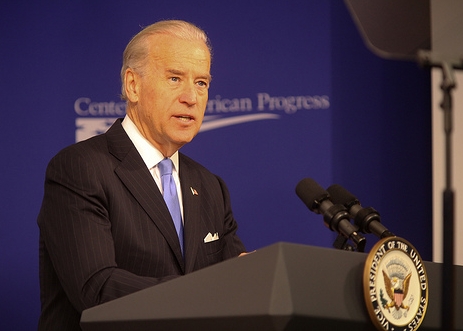On Dec. 15, Vice President Joe Biden released a “Progress Report: Transformation to a Clean Energy Economy.” It documents the advances in clean energy investments and job creation during the first year of the Obama Administration. Biden determined that the American Recovery and Reinvestment Act, and administrative actions are
laying the foundation for a clean energy economy that will create a new generation of jobs, reduce dependence on oil and enhance national security.
Secure · Tax deductible · Takes 45 SecondsSecure · Tax deductible · Takes 45 Seconds“The Recovery Act investments of $80 billion for clean energy will produce as much as $150 billion in clean energy projects” due to leveraging private investment.
The Report estimates that just three programs with $29 billion in spending will leverage an additional $52 billion in private investments and create nearly 900,000 jobs. This is would reduce the number of unemployed workers by 6 percent, and the lower the overall unemployment rate from 10 percent to 9.4 percent.
| Program | ARRA $ (billions) | Jobs from ARRA $ | Leveraged Private $ (billions) | Jobs from leveraged $ | Total Jobs |
| Renewable and advanced manufacturing |
$23 |
253,000 |
$43 |
469,000 |
722,000 |
| Advanced energy manufacturing facilities |
$2.3 |
17,000 |
$5.4 |
41,000 |
58,000 |
| Smart grid |
$4 |
43,000 |
$4 |
61,000 |
104,000 |
| Total |
$29.3 |
313,000 |
$52.4 |
571,000 |
884,000 |
This estimate is very conservative because it does not include additional jobs from investments in advanced vehicles and batteries, energy efficiency — particularly weatherization of low income homes — and other programs:
For instance, the Department of Energy estimated that when the program weatherized 100,000 homes annually, “nationwide, the Weatherization Assistance Program generates 8,000 jobs.” Before ARRA was passed, the Weatherization program received $250 million for FY 2009. ARRA will increase this funding to $5 billion, or a 20 fold increase. Assuming this would lead to proportionate increase in employment, the ARRA weatherization funding would yield a total of 160,000 jobs, which means that ARRA would generate over 1.4 million clean energy jobs.
The Vice President’s evaluation found many other profound changes brought by ARRA and other clean energy policies.
- Renewable electricity from the sun, wind and other sources will double between Jan. 1, 2009 and 2012.
- Domestic renewable manufacturing capacity to produce wind turbines, solar panels and other equipment would double during this same time.
- Fuel economy would increase by nearly 9 percent by the end of 2010.
- Home energy efficiency retrofits would increase by ten fold — from 100,000 homes annually on January 1, 2009 to one million homes annually by 2012.
Despite the positive impact of ARRA, unemployment is still too high at 10 percent. Last week, President Obama proposed a series of programs to promptly increase employment, including
a new program to provide incentives for consumers who retrofit their homes to become more energy-efficient, which we know creates jobs, saves money for families, and reduces the pollution that threatens our environment. And I’m proposing that we expand select Recovery Act initiatives to promote energy efficiency and clean energy jobs which have been proven to be particularly popular and effective.
Congress also plans to pass legislation to speed job creation. House Majority Leader Steny Hoyer (D-Md.) indicated a week ago that the House could act before Congress departs for its winter recess (subscription only), though action early in January is more likely. The House of Representatives Sustainable Energy and Environment Coalition (SEEC) proposed inclusion of a number of clean energy jobs policies for any jobs bill. Thirty eight representatives in SEEC, led by Representatives Jay Inslee (D-Wash.) and Steve Israel (D-N.Y.), wrote to Speaker of the House Nancy Pelosi (D-Calif.) and Majority Leader Hoyer to urge that additional jobs creation policies build on
“the success of the American Recovery and Reinvestment Act” by making “targeted investments and incentives for energy efficiency [that] can create jobs quickly while lowering energy costs around the country.”
The SEEC proposal urges that jobs creation legislation include a
focus on residential, commercial and industrial energy efficiency retrofits, increased investments and tax incentives for renewable energy, and funding for transportation, water infrastructure, and lands projects.
The proposal includes President Obama’s “Home Star” program to help home owners retrofit their houses for energy efficiency. The SEEC letter also offers a number of other clean energy jobs policies promoted by the Center for American Progress and environmental organizations.
- Efficiency retrofits for federally assisted housing.
- Property Assessed Clean Energy (PACE) bonds to help provide financing for energy efficiency measures for residential and commercial buildings.
- Establish a Clean Energy Deployment Administration to help deploy breakthrough clean energy technologies.
- Continue successful Department of Energy programs funded under ARRA but were over subscribed.
- Use more transportation funds for transit system operating costs to avoid service or job cuts.
These and SEEC’s other proposals would reduce energy use, save families money, create jobs, and reduce global warming pollution. Hopefully, Congressional leaders will include these proposals in any job creation legislation.




